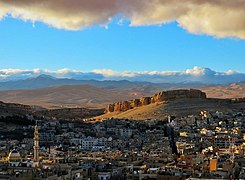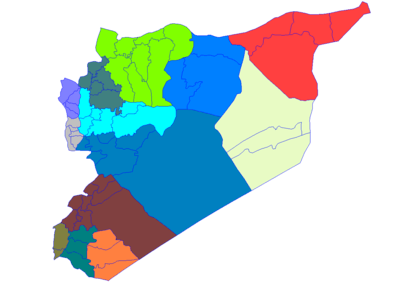Yabroud
Yabroud or Yabrud (Arabic: يبرود) is a city in Syria, located in the Rif Dimashq (i.e. Damascus' countryside) governorate about 80 kilometres (50 mi) north of the capital Damascus. According to the Syria Central Bureau of Statistics (CBS), Yabroud had a population of 25,891 in the 2004 census.[1]
Yabroud يبرود Jabrud | |
|---|---|
 Streetview | |
 Yabroud Location in Syria | |
| Coordinates: 33°58′N 36°40′E | |
| Country | |
| Governorate | Rif Dimashq |
| District | Yabroud |
| Subdistrict | Yabroud |
| Elevation | 1,550 m (5,090 ft) |
| Population (2004 census)[1] | |
| • City | 25,891 |
| • Metro | ~50,000 |
| Area code(s) | 12 |
Etymology
The name Yabroud is said to have originated from an Aramaic word meaning "cold"; the city rests upon the Qalamun Mountains slopes (Anti-Lebanon) at a height of 1,550 m.
History
The city is known for its ancient caves, most notably the Iskafta cave (where, in 1930, a thirty-year-old German traveller and self-taught archeologist Alfred Rust made many important pre-historical findings),[2] which dates back to a period known as Jabroudian culture, named after Yabroud;[3] and the Yabroud temple, which was once Jupiter Yabroudis 's temple but later became "Konstantin and Helena Cathedral". Yabroud is home of the oldest church in Syria.[4] The Natufian archeological site Yabroud III is named for the town of Yabroud.
Yabroud was mentioned in the pottery tablets of Mesopotamia in the 1st century B.C., and Ptolemy's writings in the 2nd century A.D.[5]
During the Syrian Civil War the City was the center of the Battle of Yabroud in March 2014.
Notable people
- The parents of former President of Argentina Carlos Menem were both born in Yabroud; they emigrated to Argentina before the end of World War I.
- Antun Maqdisi (1914–2005), a Syrian philosopher, politician and human rights activist, died in Yabroud.
- Gregory Atta lived for a time in Yabroud
- Youssef Halaq (1939–2007), a Syrian writer and literary translator.
- Zaki Konsoul (1916–1994), a poet and writer.
- Khaled M. Al Baradea (1934–2008), a poet and writer.
- Asem Al Basha (born 1948), an artist and writer.
References
- General Census of Population and Housing 2004. Syria Central Bureau of Statistics (CBS). Rif Dimashq Governorate. (in Arabic)
- Alfred Rust (1950). "Ancient Yabroud (Yabrud)".
- Renfrew, Colin; Bahn, Paul (2014). The Cambridge World Prehistory. Cambridge University Press. ISBN 9781107647756. "The transitional period between the Acheulian and Mousterian, named after the finds of Alfred Rust at the Yabrud I rock shelter".
- "Syria: An attempt to live a normal life - BBC News". bbc.co.uk. Retrieved 2016-03-28.
- "Yabroud city, historical and archaeological wealth". SANA. 19 November 2018.
Gallery
 Iskafta cave
Iskafta cave Overview of Yabroud
Overview of Yabroud

